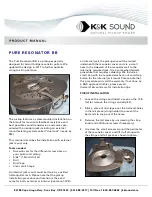
7 |
P a g e
The output transformer in the Sheriff 22 has 2 separate secondary windings; a 16 Ohm
and an 8 Ohm. This makes it easy to connect different combinations of speakers. There
are three speaker output jacks: 2 x 8 Ohms, (wired in parallel) and 1 x 16 ohms.
So here are the possible combinations:
1.
For a single 8 Ohm cabinet, use either of the 8 Ohm sockets.
2.
For a single 16 Ohm cabinet, use the 16 Ohm socket.
3.
For a pair of 16 Ohm cabinets, use both of the 8 Ohm sockets.
If you wish to use a pair of 8 Ohm cabinets, this can be done using a series lead which
results in a 16 Ohm impedance and will then use the 16 Ohm speaker socket. These leads
are not readily available and would need to be made specially. Alternatively, Palmer
offers a tiny speaker matching box which allows 2 x 8 Ohm cabinets to run in series from
a 16 Ohm output:
http://www.palmer-germany.com/mi/en/CAB-M-Passive-Cabinet-Merger-PCABM.htm
http://www.andertons.co.uk/misc-guitar-accessories/pid45717/cid590/palmer-cab-m-passive-cabinet-merger.asp
LOW POWER SPEAKER OUTPUT
The Sheriff 22 also has a dedicated low-power speaker output. This is connected to a
power-soak inside the amp and allows for low-volume playing at home at a maximum of
0.3Watts while retaining all of the amplifiers gain and tone characteristics. Any
impedance speaker cabinet can be used with this output, 4 Ohms, 8 Ohms, or 16 Ohms.
Please ensure the amp is switched to PREHEAT or OFF before swapping speaker outputs.
Also note that even this very low output power can still be quite loud so be aware of who
you may be affecting. Victory takes no responsibility for any physical or verbal abuse that
may result from your playing.
FX LOOP
The Sheriff 22 has an effects loop, which is a simple, low impedance, series loop.
The SEND socket is for connection to the input of effects units. On the Sheriff 22 it is a
lower impedance version of the signal that appears at the INPUT. Use the send to connect
to floor pedals or rack effects such as Delay, Chorus and Reverb etc. Effects such as
Overdrive, Fuzz, Wah Wah and Tuners often give better results plugged into the
Instrument Input on the front panel. The Send socket can also be used on its own to send
a signal to another amplifier.
The RETURN socket is for connection to the output of effects units. When not used it is
internally connected to the SEND, therefore the FX LOOP can be ignored if not in use. It
can also be used as a small signal ‘Slave’ input from another amplifier but DO NOT plug an
amplifier’s speaker output into the Return socket or very bad things will happen.
The RETURN socket is also very useful for fault diagnosis. If your amp doesn’t produce any
sound when played, plug the guitar directly into the RETURN socket and play. This
bypasses the entire pre-amplifier section and sends the guitar signal through just the


























